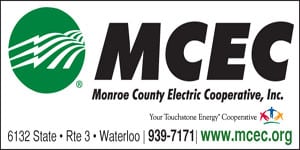Local schools among tops in state
The Waterloo and Columbia school districts rank among the best in the state in student proficiency, according to Illinois State Report Card data.
In Waterloo, 61.6 percent of students scored in the proficient range across the three subjects of the state tests. In Columbia, 60.9 percent of students scored in the proficient range.
That is good for ninth and 12th in the state among unit school districts statewide, respectively. Among large unit districts, Waterloo ranked sixth and Columbia ranked eighth.
“Our teachers deserve an enormous amount of credit for this,” Waterloo Superintendent Brian Charron said. “We have really good kids from a really good community. We have really good teachers, too, that really care about them, and it shows.”
The sentiment was similar in Columbia.
“It’s probably a combination of outstanding and dedicated teachers who are working with a curriculum we strive to align with state standards,” Columbia Assistant Superintendent Courtney Castelli said of the scores. “Our administrative team works closely in collaboration with the teachers to support the instructional best practices in those different areas. So it’s really a collaborative effort between the administration and the teachers.”
“Our district is also very fortunate to have very supportive families who are actively engaged in the education of their children,” Castelli added. “The students, generally, come to us ready to learn and willing to learn.”
The overall proficiency score is created by averaging the percentage of students who scored in the proficient range in tests on English/language arts, math and science.
Students from elementary through high school levels are tested, depending on the district. The tests vary by grade level, with one example being the Illinois Assessment of Readiness, which grades 3-8 students take and covers ELA and math.
There are 390 unit school districts in Illinois that submit data for the Illinois State Report Card, which can be accessed at illinoisreportcard.com.
In ELA, Waterloo ranks 11th in the state and sixth among large unit districts. The percentage of students who scored proficient is 60.2.
Columbia ranks 46th and 18th in those categories, with 51.5 percent of students deemed proficient.
Columbia performs better than Waterloo, however, in math. Waterloo ranks 10th in the state and seventh among large unit districts, while Columbia is fifth and second, respectively.
Waterloo had 55.2 percent of students rank proficient in math, while Columbia had 60.1 students score in that range.
On the science assessment, Waterloo is tied for 15th in the state and ninth among large unit districts. Columbia is eighth and fifth in those same categories.
In this case, 69.4 percent of Waterloo students were proficient, while 71.3 percent of Columbia students were proficient.
Another key area where both districts performed well was in the overall proficiency of students with Individualized Education Programs.
Just over 26 percent of those students were proficient in Waterloo, whereas that number was 13.6 percent in Columbia.
While that may seem low, that ranks third and 26th in Illinois, respectively.
Those scores are based on IAR results.
“I feel it’s important to know about the students with IEPs because that’s where a lot of our resources are in both personnel and finances,” Waterloo Curriculum Coordinator Jonathan Schmieg said, noting students with IEPs are one of the largest subgroups of students.
Schmieg also said it is important for citizens to see this data because it shows how their tax dollars are being used.
“I’m a taxpayer in Waterloo also, and I want to know what our money is being used for,” he said. “And if a lot of it’s going to students with IEPs, I would like to know how that subgroup is doing.”
Castelli said she believes the numbers are important because they provide “transparency and accountability,” but noted they come from only a couple tests and the district uses additional measures of academic success.
“It’s useful for us and we do value it, but it’s just one measure,” she said.
Looking ahead, Schmieg said he is concerned about Waterloo’s performance next year because the district will be required to do all its testing online. This year, students who tested online scored 10-15 percent lower than last year.
Schmieg said the solution to that is time.
“Our teachers need time to prepare students,” he said. “Unfortunately, that’s going to take time out of the classroom in order to teach students how to take tests on the computer and practice that.”
Schmieg said the district will also be focusing on the science assessment, as the number of students taking it will drastically increase next year.
Castelli said Columbia is not too worried about the online testing, as it already does all its testing online.
The changes to the science test, though, could prove more impactful.
“It’s going to be interesting because it’s going to be kiddos who haven’t necessarily been exposed to all that curriculum yet,” Castelli said. “So we may have to make some changes because of that.”








